
Captain of the Andrea Doria, Piero Calamai, 58, had been 40 years at sea and commanded his luxurious ship on 50 successful crossings of the Atlantic.
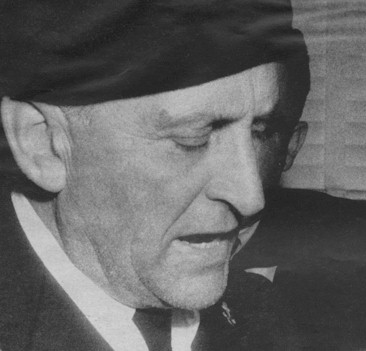
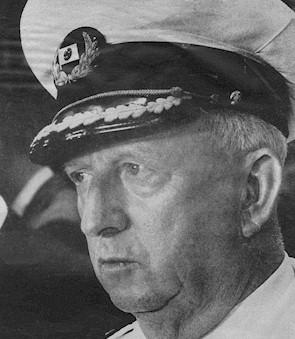
Captain Harry Gunnar Nordenson (left) with his third mate, Johan-Ernst Carstens-Johannsen. Nordenson was in his cabin when the young Carstens was in charge of the bridge at the moment of collision.
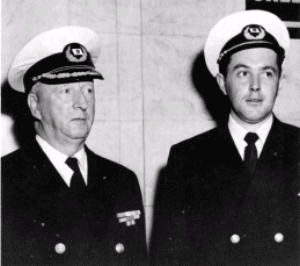


SS Andrea Doria was an ocean liner for the Italian Line (Società di navigazione Italia) home ported in Genoa, Italy, most famous for its sinking in 1956. Named after the 16th-century Genoese admiral Andrea Doria, the Andrea Doria had a gross register tonnage of 29,100 and a capacity of about 1,200 passengers and 500 crew. For a country attempting to rebuild its economy and reputation after World War II, Andrea Doria was an icon of Italian national pride. Of all Italy's ships at the time, Andrea Doria was the largest, fastest and supposedly safest. Launched on 16 June 1951, the ship undertook its maiden voyage on 14 January 1953.
On 25 July 1956, approaching the coast of Nantucket, Massachusetts bound for New York City, Andrea Doria collided with the eastward-bound MS Stockholm of the Swedish American Line in what became one of history's most famous maritime disasters. Struck in the side, Andrea Doria immediately started to list severely to starboard, which left half of her lifeboats unusable. The consequent shortage of lifeboats might have resulted in significant loss of life, but improvements in communications and rapid responses by other ships averted a disaster similar in scale to the Titanic disaster of 1912. 1660 passengers and crew were rescued and survived, while 46 people died as a consequence of the collision. The evacuated luxury liner capsized and sank the following morning.
The incident and its aftermath were heavily covered by the news media. While the rescue efforts were both successful and commendable, the cause of the collision and the loss of Andrea Doria afterward generated much interest in the media and many lawsuits. Largely because of an out-of-court settlement agreement between the two shipping companies during hearings immediately after the disaster, no determination of the cause(s) was ever formally published. Although greater blame appeared initially to fall on the Italian liner, more recent discoveries have indicated that a misreading of radar on the Swedish ship may have initiated the collision course, leading to some errors on both ships and resulting in disaster. However, the news that the crew had abandoned the passengers to their own fate dealt a marketing blow to the Italian Line it found hard to recover from.
Andrea Doria was the last major transatlantic passenger vessel to sink before aircraft became the preferred method of travel.
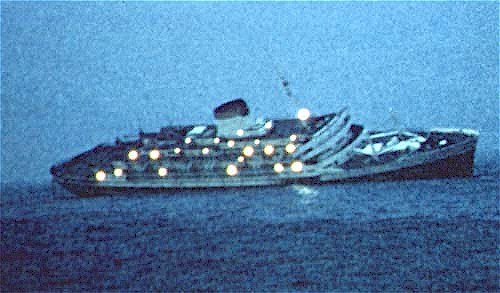
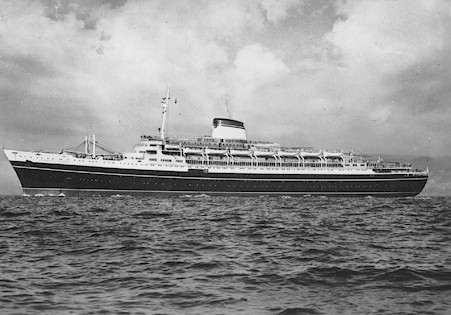
A collision course
On the evening of Wednesday, 25 July 1956, Andrea Doria, commanded by Captain Piero Calamai, carrying 1,134 passengers and 572 crew members, was heading west toward New York. It was the last night out of a transatlantic crossing from Genoa that began on 17 July. The ship was expected to dock in New York the next morning. At the same time, MS Stockholm, a smaller passenger liner of the Swedish American Line, had departed New York about midday, heading east across the North Atlantic Ocean toward Gothenburg, Sweden. Stockholm was commanded by Captain Harry Gunnar Nordenson, though Third Officer Johan-Ernst Carstens-Johannsen was in command on the bridge at the time. Stockholm was following its usual course east to Nantucket Lightship, making about 18 knots (33 km/h) with clear skies. Carstens estimated visibility at 6 nautical miles (11 km).
As Stockholm and Andrea Doria were approaching each other head-on, in the heavily-used shipping corridor, the westbound Andrea Doria had been traveling in heavy fog for hours. The captain had reduced speed slightly from 23.0 to 21.8 knots (42.6 to 40.4 km/h), activated the ship's fog-warning whistle, and had closed the watertight doors, all customary precautions while sailing in such conditions. However, the eastbound Stockholm had yet to enter what was apparently the edge of a fog bank and was apparently unaware of it. (The waters of the North Atlantic south of Nantucket Island are frequently the site of intermittent fog as the cold Labrador Current encounters the Gulf Stream.)
As the two ships approached each other, at a combined speed of 40 knots (74 km/h), each was aware of the presence of another ship but was guided only by radar; they apparently misinterpreted each others' courses. There was no radio communication between the two ships.
The original inquiry established that in the critical minutes before the collision, Andrea Doria gradually steered to port, attempting a starboard-to-starboard passing, while Stockholm turned about 20 degrees to its starboard, an action intended to widen the passing distance of a port-to-port passing. In fact, they were actually steering towards each other — narrowing, rather than widening, the passing distance. Compounded by the extremely thick fog that enveloped the Doria as the ships approached each other, the ships were quite close by the time visual contact had been established. By then, the crews realized that they were on a collision course, but despite last-minute manoeuvres, they were unable to avoid the collision.
In the last moments before impact, Stockholm turned hard to the starboard and was in the process of reversing its propellers attempting to stop. The Doria, remaining at its cruising speed of almost 22 knots (41 km/h) engaged in a hard turn to port, its Captain hoping to outrun the collision. At approximately 11:10 PM, the two ships collided.
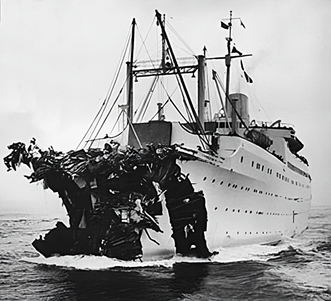
Impact and penetration
When Andrea Doria and Stockholm collided at almost a 90-degree angle, Stockholm's sharply raked ice breaking prow pierced Andrea Doria's port side approximately midway of its length. It penetrated three passenger cabins, numbered 52, 54, and 56 to a depth of nearly 40 feet (12 m), and the keel. The collision smashed many occupied passenger cabins and, at the lower levels, ripped open several of Andrea Doria's watertight compartments. The gash pierced five fuel tanks on Andrea Doria's starboard side and filled them with 500 tons of seawater. Meanwhile, air was trapped in the empty tanks on the port side, contributing to a severe, uncorrectable list. The ship's large fuel tanks were mostly empty at the time of the collision, since the ship was nearing the end of its voyage.
Meanwhile, on the bridge of Stockholm, immediately after the impact, engines were placed at ALL STOP, and all watertight doors were closed. The ships were intertwined for about 30 seconds. As they separated, the smashed bow of the stationary Stockholm was dragged aft along the starboard side of the Doria, which was still moving forward, adding more gashes along the side. The two ships then separated, and the Doria moved away into the heavy fog. Initial radio distress calls were sent out by each ship, and in that manner, they learned each others' identities.
The world soon became aware that two large ocean liners had collided.
This was the SOS sent by Andrea Doria:
"SOS DE ICEH SOS HERE AT 0320 GMT LAT. 40.30 N 69.53 W NEED IMMEDIATE ASSISTANCE"
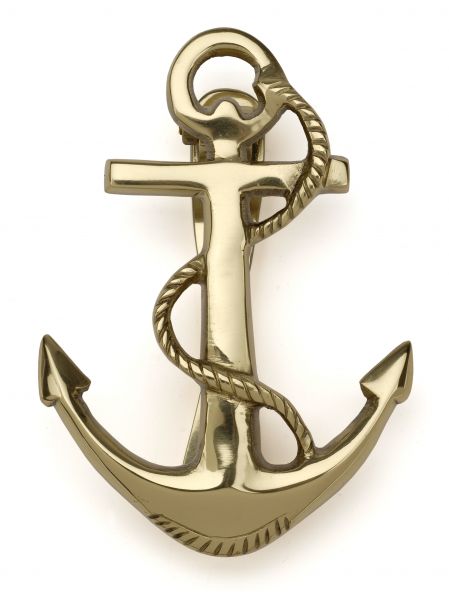
2 comments:
It is quite simple. Stockhol Captain Nordenson went to his cabin and fell asleep. Young Carstens remained on the captain's bridge. As it now turns out, Johannsen misread the radar readings and steered his ship so that it was actually chasing Andrea Doria. This greatly confused Andrea Doria Commander Calamai. In fact, it was no longer known how to bring the ship to a safe position. Captain Nordenson is to blame because he trusted his routine and left his post in this very difficult to navigate sea area, handing over his duties to the young 3rd officer. Captain Nordenson was an American citizen and was defended during the trial while the whole mistake was turned against Captain Calamai. Such kind of injustice could take place only in the United States court which greedily defended Nordenson, their own citizen.
This is exactly what happened.
Post a Comment